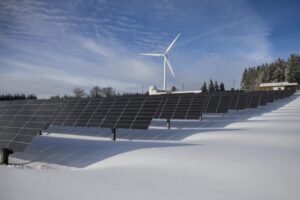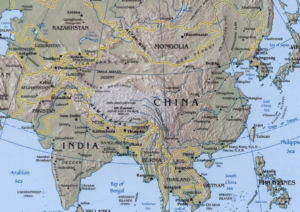- Energy storage stabilizes the variations that renewable sources suffer in energy production.
- With new energy storage technologies, more countries may be self-sufficient.
- High-scale renewable energy production will change the power relationship between energy producing and consuming countries.
With the objective and growing need to reduce impacts on the environment, renewable energy sources are one of the main horizons to make production cleaner.
However, something that prevents its massification is still the instability of production when we depend on natural sources such as the sun or the winds. To solve this problem, new technologies of storage of surplus energy have been developed and can popularize clean production on a large scale.
With the possibility of a new energy dynamic, commercial and geopolitical relations will be directly affected, mainly by changing the centrality that fossil fuels have in the energy market.

The disadvantages of using renewable energy sources
Even with the need to transition to clean energy, renewable sources still need a lot of technology involved to become a reality.
When relying on renewable sources, such as wind and solar, there is an instability in relation to the realization and production of energy. The wind and the sun are able to generate high energy, but in a variable way, since they are natural factors. For example, in high wind days there will be greater energy production, unlike days with fewer drafts.
The lack of stability is something difficult to establish in the market, since this brings price fluctuations, depending on production and demand.
In addition, we are still at a time of evolution of energy storage technologies. As we do not yet have advanced and large-scale energy storage systems, when there is the production of energy by renewable sources, the surplus energy is lost or unused .
With a more advanced storage technology, these natural variations of renewable sources will no longer be a problematic issue, since in times of low production and high demand, there is stored energy that could satisfy the demand.
By solving the storage problem, clean energy can become the main global production. But until then, this inconstancy of production still affects a growth and larger scale in this way more “green”.
How to enable and expand the use of renewable energy sources
It is from the technological advancement that new energy sources less harmful to the environment can become more conventional.
2020 studies show that the energy consumption of renewable sources (solar and wind mainly) grew 21.5% in 2020, with a tendency to have been even greater if there was no Covid-19 pandemic. Another fact that shows the growth of clean energy is that from 2018 to 2019 there was a growth of 22% of solar energy production and 10% of wind energy.
This demonstrates that production itself is not a problem for the popularization of clean energy.
But the biggest problem is the lack of high-scale storage of this form of energy production. For the transition and realization of a cleaner future, major investments in new energy storage technologies are necessary.
The 4 most promising ways to store energy produced by renewable sources
The energy stock works to balance the relationship between production and demand. In times of high production but low demand, it is possible to create an energy reserve, which will be used when production is low but there is high demand.
Storage systems bring several economic benefits, since it allows more stability, reliability and less harmful effects on the environment.
Depending on the extension of the storage network, this system is able to optimize utility networks, increasing their efficiency, reducing the likelihood of falls during peak demands and will allow more renewable resources to be used and built.
The main clean energy storage technologies currently are:
- Reversible hydroelectric plant – Reversible hydraulic pump
About 90% of the world stores energy from the pumped hydroelectric calls, where a funnel uses excess energy to pump water to a reservoir located in a higher region, which is released at times of high energy demand, force to generate energy by turbines.
The problem with this model is that it depends on specific geographical terrain formations and water abundance, as well as being a very expensive project to build. However, it is a technology with proven efficiency and cost effectiveness.
- Green Hydrogen
The green hydrogen is the result of the separation of hydrogen from oxygen (called electrolysis process) through renewable sources, producing energy. The generation of energy by hydrogen is more efficient than those based on fossil fuels, being able to provide energy to large electrical networks and create large batteries that store energy.
Hydrogen batteries are capable of storing about 30% of the surplus energy produced by renewable sources. And when hydrogen stored for energy is used, there is no emission of polluting gases, only water.
- Lithium Batteries
Lithium batteries are the most used in technological devices today, such as laptops, mobile phones, and electric cars.
They are the biggest promise of energy storage technology in the future. Lithium is one of the elements with high electrochemical potential and to accumulate large amounts of energy. 2018 tests were able to store 9GW/17 GWh, with forecast to increase this capacity to 1,095 GW/2,850 GWh by 2040.
One of the biggest struggles for its popularization is its current cost, currently the larger producers of lithium are Argentina (16%) and Chile (40%), but the largest ore refiner is the China.
But this is changing, there is the 50% cost reduction forecast of battery production by 2030. Still, for the advancement of technology, it is estimated the need for an investment of about US$ 662 billion.
- Thermal storage
For energy to be stored, it is necessary to transform it into mechanical, chemical or thermal energy. Thermal storage transforms surplus electrical energy into thermal energy, which allows it to be reused at any time.
It consists of accumulating energy in materials that allow their retention and release in a controlled way, through methods ranging from cooling, through the accumulation of ice, to exposure to extremely high temperatures.
Why the viability of renewable energy sources can affect global energy geopolitics
From the moment countries have larger energy storage systems, and not only production, it is possible to achieve greater energy self-sufficiency and national sovereignty.
Thus, at a time of greater massification of energy storage, more countries will become less dependent, which changes the international trade dynamics mainly for those nations that export fossil fuels, such as Saudi Arabia, Australia, United Arab Emirates, Venezuela and many others.
Countries that depend heavily on the import of these fuels, such as India and Japan, may experience economic growth with these technologies.
At the same time, something that might happen is a new power struggle.
If these technologies work and are profitable on a small scale the possibility of building them in larger volumes can become a new reality, without relying on network operators and power transmission.
But if it depends only on the large scale to be profitable, transmission and power grid operators will become key players. Especially if only they have a larger storage capacity, becoming as “energy banks” where energy producers will deposit the energy surplus and withdraw it in times of deficit.
It consists of accumulating energy in materials that allow their retention and release in a controlled way, through methods ranging from cooling, through the accumulation of ice, to exposure to extremely high temperatures.
Anyway, these new technologies can actually popularize renewable sources, which is one of the major goals to reduce environmental impacts. What is an increasingly growing need for our society.
From an energy matrix based on fossil fuels to an energy matrix based on renewable energy
The change to a clean energy matrix, by renewable energy sources can bring greater market diversification and democratization of countries, even if at first the countries exporting fossil fuels and that have this sale as the main source of national income experience by an authoritarianism sustained by the wealth of fossil fuels.
Since short-term market change price resources up to stabilization and this affects the political context.
With storage technologies the variations of renewable energies will be stabilized, which will make them a more reliable energy source in relation to production, enabling its growth in several countries.
Thus, it will be possible to produce clean energy that, in the long term, may become the new main form of world energy, which follows the objectives of reducing the harmful effects on the environment.
The future trend of clean energy storage and how this may affect the power relationship between energy producing and consuming countries
With this change in the global energy matrix of fossil fuels for renewable energy sources, oil-exporting countries and natural gas will lose economic power and geopolitical influence. At the same time, energy-intensive countries will be able to reduce their dependence on fossil fuel exporters and thus increase their energy and strategic sovereignty.
For example, in this future scenario Russia would lose its power to blackmail and influence the foreign policies of importing European countries of Russian gas. And at the same time, European countries (major energy consumers) would “clean up” their energy production through renewable sources with storage capacity, thus gaining more geopolitical independence.
Clean and cheap energy would strengthen the economy and public institutions of these consuming countries and weaken many authoritarian governments around the world as the vast majority of fossil fuel exporting countries are ruled by autocrats. That is, a change in the world energy matrix would not only be good for the environment, but would also help to build a more democratic and liberal world.















[…] Act (Inflation Reduction Act) was a new initiative of the government of Joe Biden to transition to renewable energy sources. This law will mobilize US$700 billion with the aim of environmental improvement, reduction of […]
[…] citizens want projects built for the public good — such as affordable housing, rail, roads and renewable energy sources — but they don’t want to be anywhere near […]
[…] There are four main ways to store sustainable energy: […]
[…] its free form and therefore needs to be produced. It is recognized as an energy vector, having the ability to store energy for later […]
[…] solar panels become protagonists when it comes to green energy generation. Producing energy from sunlight, the panel structure contains various minerals in its […]
[…] importing LNG is its high cost. This cost derives from the necessary infrastructure for liquefying, storing, transporting and regasifying the […]